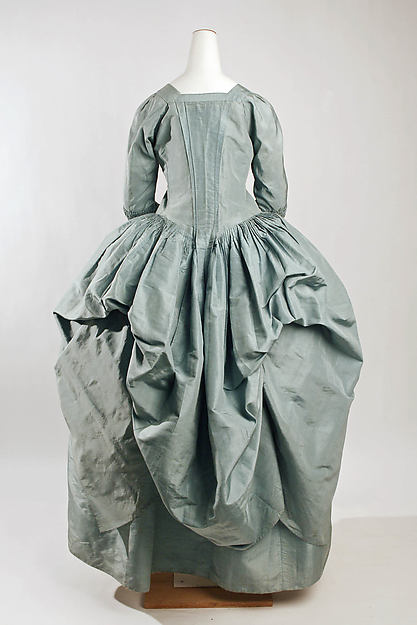Note that there are different types of robes à la Polonaises. The style merely means that the outer skirt has been hooped up to create three wings on the back of the skirt. However, it is quite similar to a robe à l'Anglaise or à la Française retrousée. The difference is that these retrousées are gowns that were originally made as either an l'Anglaise or an la Française but has had its outer skirt scooped up into the three wings.
Also, for a robe à l'Anglaise retrousée has a completely closed bodice whereas a robe à la Polonaise is only closed at the very top of the bodice. However, some are very difficult to categorize. I have chosen to gather all these together to show the differences and follow the description given by the museums.
White or Cream
French silk robe à la Polonaise, 1780
Could be either a robe à la Polonaise or l'Anglaise retroussé but it is hard to tell, 1776-80
Scottish robe à la Polonaise which was likely used during pregnancy due to the wide bodice, 1770's. This gown is a perfect example of how robes à la Polonaises were closed at the top of the bodice.
Norwegian or Danish (technically both since it was one country) robe à l'Anglaise retroussé, 1750-89
English robe à la Polonaise, 1775
Yellow
Dutch robe à l'Anglaise retroussée, 1780-82
English silk robe à la Polonaise, 1775-80
German robe à la Polonaise, 1775

British silk robe à la Polonaise, 1775

British robe à l'Anglaise retroussée,

Italian robe à la Polonaise, 1787

Orange
Robe à la Polonaise, c. 1780

Red
Robe à l'Anglaise retroussée, late 1770's
Red silk robe à la Polonaise, 1770-80
Robe à la Française retroussé, 1770-90
Pink
Pink and green taffeta robe à la Polonaise, 1780-85
French robe à la Française retroussée, 1775
Robe à la Polonaise, 1778-80
Spanish robe à l'Anglaise retroussé - it could very well pass for a Polonaise but there is a seam at the waist which only the l'Anglaises has, 1775-80
Blue
British silk robe à l'Anglaise retroussée, 1780's

Robe à la Polonaise, 1770-80's
Green

Brown
German robe à la Polonaise, 1785




























No comments:
Post a Comment